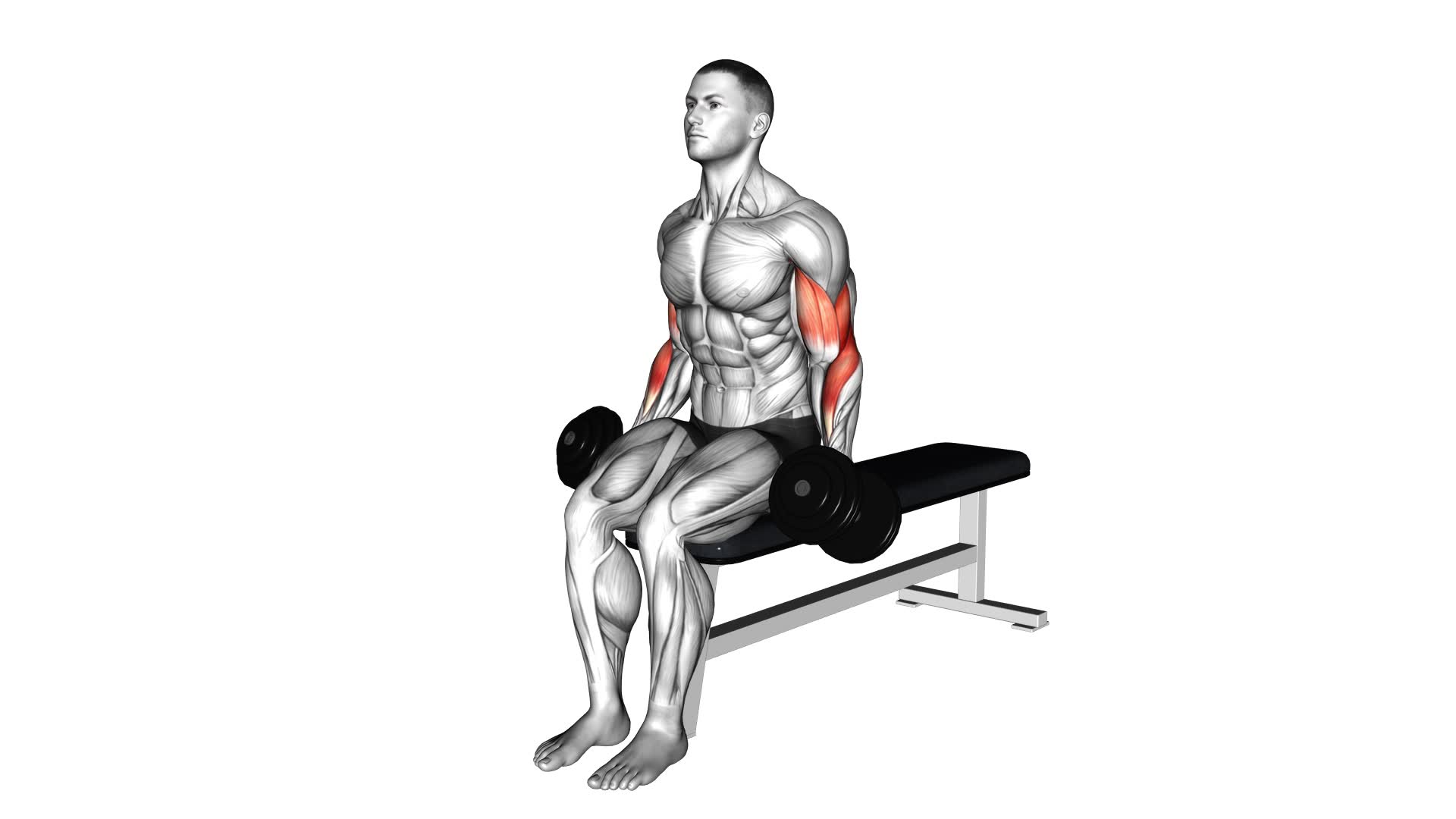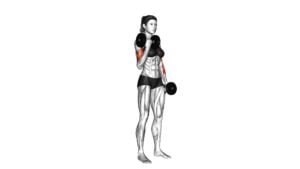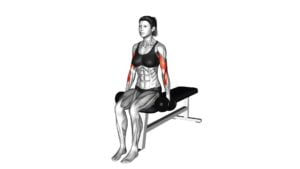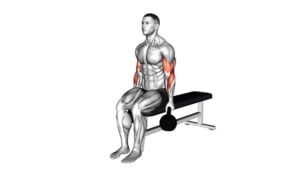Dumbbell Alternate Biceps Curl – Video Exercise Guide & Tips

Are you looking to build stronger biceps? Look no further than the dumbbell alternate biceps curl! This exercise targets your biceps muscles and can help increase arm strength and definition.
Watch This Exercise Video
In this video exercise guide, we'll show you the proper form and technique, as well as provide helpful tips to maximize your bicep growth.
So grab those dumbbells and get ready to pump up those guns!
Key Takeaways
- Targets biceps muscles
- Increases arm strength and definition
- Helps improve muscle imbalances
- Works each arm separately
Benefits of the Dumbbell Alternate Biceps Curl
You can achieve stronger and more defined biceps by incorporating the dumbbell alternate biceps curl into your workout routine. The dumbbell alternate biceps curl is one of the most effective dumbbell curl variations that targets your biceps muscles. By performing this exercise, you can work each arm separately, which helps to improve muscle imbalances and ensures that both arms receive equal attention and stimulation.
Incorporating dumbbell curls into your workout routine has several benefits. Firstly, it helps to increase the size and strength of your biceps. The dumbbell alternate biceps curl specifically targets the biceps brachii, which is the main muscle responsible for flexing the elbow joint. By consistently performing this exercise, you can progressively overload your biceps, leading to hypertrophy and increased strength.
Secondly, incorporating dumbbell curls into your workout routine can improve your overall arm aesthetics. By developing well-defined biceps, you can enhance the appearance of your arms and create a more balanced physique. This is especially beneficial if you're interested in bodybuilding or simply want to have more toned and sculpted arms.
To maximize the benefits of the dumbbell alternate biceps curl, it's important to perform the exercise with proper form and technique. Make sure to maintain a neutral spine, engage your core, and avoid using momentum to lift the weights. Start with a weight that challenges you but allows you to complete the desired number of repetitions with proper form.
Proper Form and Technique for the Exercise
To ensure proper form and technique for the dumbbell alternate biceps curl, it's important to pay attention to the position of your elbows. Keep them close to your sides and stationary throughout the exercise to effectively target the biceps muscles.
Additionally, avoid swinging motions or using momentum to lift the weights, as this can decrease the effectiveness of the exercise and increase the risk of injury.
Elbows Position Importance
The proper form and technique for the dumbbell alternate biceps curl requires maintaining a correct position of the elbows. This is crucial for achieving optimal muscle activation and preventing injury. Here are three reasons why proper alignment of the elbows is important:
- Reduced strain: Keeping your elbows close to your sides throughout the exercise helps to minimize strain on the shoulder joints and reduces the risk of overuse injuries.
- Effective muscle activation: By keeping your elbows stationary and locked in place, you ensure that the biceps muscles are the primary movers in the exercise, leading to more effective muscle activation and growth.
- Improved form: Maintaining proper elbow alignment improves your overall form, allowing you to focus on the targeted muscles and get the most out of each repetition.
Avoiding Swinging Motions
To avoid swinging motions during the dumbbell alternate biceps curl exercise, maintain control and stability throughout each repetition. Swinging can reduce the effectiveness of the exercise and increase the risk of injury.
Start by standing with your feet shoulder-width apart, knees slightly bent, and core engaged. Keep your upper body still and avoid using momentum to lift the weights. Focus on isolating the biceps muscles and perform the movement in a slow and controlled manner.
Maintain a firm grip on the dumbbells and keep your elbows close to your sides. Avoid bending your wrists or leaning backward.
Choosing the Right Weight for Your Fitness Level
To choose the right weight for your fitness level, there are a few techniques you can use.
First, consider your current strength and abilities when selecting a weight. Start with a weight that allows you to complete the exercise with proper form, but still challenges your muscles.
Weight Selection Techniques
Choose the appropriate weight for your fitness level by considering your current strength and capabilities. It's important to select a weight that challenges you without causing overexertion. Here are some weight selection tips to help you make the right choice:
- Start with a lighter weight and gradually increase as you become stronger.
- Listen to your body and choose a weight that allows you to maintain proper form throughout the exercise.
- Avoid using weights that are too heavy, as this can increase the risk of injury.
By following these weight selection techniques, you can ensure a safe and effective workout.
Now, let's move on to the next section where we'll discuss fitness level considerations.
Fitness Level Considerations
Consider your current strength and capabilities when selecting the appropriate weight for your fitness level, ensuring that it challenges you without causing overexertion. It's important to make fitness modifications based on your individual needs and goals.
If you're a beginner, start with lighter weights to master the proper form and technique. As you progress and become stronger, gradually increase the weight to continue challenging your muscles.
On the other hand, if you're already an experienced lifter, you may need heavier weights to maintain the effectiveness of your workouts. Remember, injury prevention should always be a priority. Using weights that are too heavy can lead to muscle strains or joint injuries.
It's crucial to find the right balance between pushing yourself and avoiding unnecessary risks.
Avoiding Injury Risks
When selecting the appropriate weight for your fitness level, it's important to take into account injury risks and choose a weight that challenges you without causing overexertion. Injury prevention should always be a priority in your fitness routine. Here are some key tips to keep in mind:
- Warm up exercises: Before starting any weightlifting exercise, it's crucial to warm up your muscles to increase blood flow and flexibility. This can help reduce the risk of strains or tears.
- Start light: It's better to start with a weight that feels slightly easy and gradually increase the intensity as you become stronger. Pushing yourself too hard from the beginning can lead to injury.
- Listen to your body: Pay attention to any pain or discomfort while performing the exercise. If something doesn't feel right, stop immediately and consult a professional.
Common Mistakes to Avoid During the Exercise
To maximize your results and prevent injury, be mindful of these common form errors during the dumbbell alternate biceps curl exercise. First and foremost, avoid using excessive momentum to lift the dumbbells. This often happens when you swing your arms or use your back to assist the movement. Instead, focus on isolating the biceps by keeping your upper arms stationary and using only your forearms to curl the weights.
Another mistake to avoid is using weights that are too heavy. While it may be tempting to lift heavier weights for a greater challenge, using improper form due to excessive weight can lead to strain or injury. Start with a weight that allows you to perform the exercise with proper technique and gradually increase as your strength improves.
Improper grip is another common mistake. Make sure to grip the dumbbells firmly, with your palms facing upward throughout the movement. Avoid letting the weights slip or rotate in your hands, as this can strain the wrists and lead to discomfort.
Lastly, avoid arching your back or leaning forward during the exercise. This can put unnecessary strain on your lower back and compromise your form. Keep your back straight, engage your core, and maintain a stable posture throughout the entire movement.
By avoiding these common mistakes and practicing proper form, you can optimize your gains and reduce the risk of injury during the dumbbell alternate biceps curl exercise.
Now, let's move on to discussing variations and progressions for advanced lifters.
Variations and Progressions for Advanced Lifters
To further challenge advanced lifters and continue the discussion from common mistakes to avoid, let's explore some variations and progressions for the dumbbell alternate biceps curl exercise. These variations and strategies will help you take your biceps workout to the next level, ensuring continued growth and strength gains.
Here are three variations to consider:
- Hammer Curl: Instead of turning your palms up during the curl, keep them facing each other throughout the movement. This targets the brachialis muscle, which lies underneath the biceps, giving your arms a more complete look.
- Preacher Curl: Perform the biceps curl on a preacher bench, with your upper arms resting on the sloped pad. This isolates the biceps and prevents cheating by using momentum. It also reduces strain on the wrists and elbows, making it a great option for those with joint issues.
- Concentration Curl: Sit on a bench and rest your elbow on the inside of your thigh. While holding a dumbbell, curl your arm up towards your shoulder, focusing on squeezing the biceps at the top of the movement. This exercise increases the mind-muscle connection and helps develop peak contraction in the biceps.
Incorporating these variations into your routine will challenge your muscles in new ways, leading to continued growth and progress. Remember to use proper form and gradually increase the weight as you become stronger.
Tips for Maximizing Your Bicep Growth With This Exercise
Maximize your bicep growth with this exercise by incorporating these tips.
To ensure maximum effectiveness and growth of your biceps, it's important to focus on proper form and technique. First, start with a weight that challenges you, but allows you to maintain good form throughout the exercise. This will ensure that you're targeting the biceps effectively and minimizing the risk of injury.
Secondly, maintain a controlled and slow movement throughout the exercise. Avoid using momentum or swinging the weights, as this takes the emphasis away from the biceps and reduces the effectiveness of the exercise.
Additionally, make sure to fully extend your arms at the bottom of each repetition, and squeeze your biceps at the top of the movement to engage the muscle fully.
Lastly, it's important to incorporate progressive overload by gradually increasing the weight or the number of repetitions over time. This will stimulate muscle growth and ensure continual progress.
Frequently Asked Questions
How Many Repetitions and Sets Should I Perform for the Dumbbell Alternate Biceps Curl?
To determine the number of sets and reps for the dumbbell alternate biceps curl, you need to consider your fitness goals and current level of strength.
It's recommended to start with 2-3 sets of 8-12 reps per arm.
Choose a weight that challenges you, but still allows for proper form.
Gradually increase the weight as you become stronger.
Remember to listen to your body and adjust the sets and reps accordingly.
Can I Use This Exercise to Target Other Muscles Besides the Biceps?
Yes, the dumbbell alternate biceps curl can be used to target other muscles besides the biceps. By incorporating different variations of this exercise, such as adding a twist or performing it on an incline bench, you can engage other muscle groups like the forearms, shoulders, and core.
To properly perform this exercise, hold a dumbbell in each hand, curl one arm up while keeping the other arm stationary, and repeat on the opposite side.
Is It Better to Perform the Exercise Standing or Sitting?
When it comes to the Dumbbell Alternate Biceps Curl, you may be wondering whether it's better to perform the exercise standing or sitting.
The choice between standing and sitting can affect muscle activation and stability. By standing, you engage more core muscles and improve overall stability.
On the other hand, sitting allows you to isolate the biceps more effectively.
Consider your goals and preferences to determine which position works best for you.
Can I Incorporate This Exercise Into a Full-Body Workout Routine?
You can definitely incorporate dumbbell curls into a full-body workout routine. Adding this exercise to your routine can provide numerous benefits for overall strength and fitness.
Dumbbell curls specifically target your biceps, but they also engage your forearms and shoulders to a lesser extent. This exercise helps to build upper body strength and can improve your overall muscular endurance.
Are There Any Modifications or Alternatives for Individuals With Wrist or Elbow Injuries?
If you have wrist or elbow injuries, there are modifications you can make to the dumbbell alternate biceps curl exercise. Instead of using dumbbells, you can try using resistance bands or cables, which put less strain on the wrists and elbows.
Additionally, you can perform exercises like hammer curls or preacher curls, which target the biceps without putting as much stress on the wrist and elbow joints.
It's important to consult with a professional to determine the best modifications for your specific injury.
Conclusion
In conclusion, the Dumbbell Alternate Biceps Curl is an effective exercise for building strength and size in your biceps.
By following the proper form and technique, choosing the appropriate weight, and avoiding common mistakes, you can maximize your results.
Advanced lifters can also explore variations and progressions to challenge their muscles further.
Remember to incorporate this exercise into your routine consistently and combine it with a well-rounded bicep growth plan for optimal results.

Author
Years ago, the spark of my life’s passion ignited in my mind the moment I stepped into the local gym for the first time. The inaugural bead of perspiration, the initial endeavor, the very first surge of endorphins, and a sense of pride that washed over me post-workout marked the beginning of my deep-seated interest in strength sports, fitness, and sports nutrition. This very curiosity blossomed rapidly into a profound fascination, propelling me to earn a Master’s degree in Physical Education from the Academy of Physical Education in Krakow, followed by a Sports Manager diploma from the Jagiellonian University. My journey of growth led me to gain more specialized qualifications, such as being a certified personal trainer with a focus on sports dietetics, a lifeguard, and an instructor for wellness and corrective gymnastics. Theoretical knowledge paired seamlessly with practical experience, reinforcing my belief that the transformation of individuals under my guidance was also a reflection of my personal growth. This belief holds true even today. Each day, I strive to push the boundaries and explore new realms. These realms gently elevate me to greater heights. The unique combination of passion for my field and the continuous quest for growth fuels my drive to break new ground.







